|
December 2010
Imagine
This December 8th will mark the 30th anniversary of John Lennon’s
death. He would have been 70 years old. As the story of his
life and death has been well documented, and there will undoubtedly
be many retrospectives on that date, there is no need for
any biographical notes here. Rather we choose to reflect on
Imagine, an anthem of wish for a utopian world. What
Lennon imagined to be necessary in the achievement of that
goal, is clearly stated in the lyrics:
Imagine
there’s no Heaven,
It's easy if you try
No hell below us,
Above us only sky
Imagine all the people
Living for today
Imagine there's no countries,
It isn't hard to do
Nothing to kill or die for
And no religion too
Imagine all the people
Living life in peace
You may say that I'm a dreamer
But I'm not the only one
I hope someday you'll join us
And the world will live as one
Imagine no possessions
I wonder if you can
No need for greed or hunger
A brotherhood of man
Imagine all the people
Sharing all the world
(repeat refrain)
With all due respects to Lennon, of whom we
are a big fan, he was a victim of none of the above—
countries, religion or possessions. And so we would like to
add our own stanza and a few questions and considerations
that might follow:
Imagine
no deranged people
Nor the misguided too
No assassinations
And all that might ensue
John
Fitzgerald Kennedy (May 29, 1917 -
) What would have become of the Viet Nam war? Campus
unrest? The 60’s? What would have become of Lyndon Johnson?
Where might the space program have gone if JFK would have
continued to be an advocate for further exploration?
Martin
Luther King (January 15, 1929 - )
How would the Civil Rights movement have proceeded? What role
would he have played in other movements that followed? Feminist?
Gay? His POV on Gay Marriage? What influence would he have
had in Clarence Thomas hearings for nomination to the Supreme
Court? Would a black president have come sooner? What would
he have said on the election of Obama? Did he have another
“I Have a Dream” speech in him?
Robert
Francis Kennedy (November 20, 1925 -
) Would
he have beaten Nixon? If so… what direction would the
War have taken? If so… no Watergate. No Gerald Ford.
No Chappaquiddick? Would Carter have ever been president?
Teddy? How would this have affected Ronald Reagan’s
path?
John
Winston Ono Lennon (October 9, 1940-
) What songs would have followed?
What social movements would he have been involved in and had
impact? How would the new technologies have stimulated his
creativity and “imagining?” A reunion of the Beatles
(or with McCartney) for some great cause or event? How big
would that have been, given this age of “Super Hype?”
What would he have had to say about Mark Chapman had he survived?
You
may say that I’m a dreamer
But I’m not the only one
***
A Pilgrimage to Israel; New Testament
Version: Part I
We had the good fortune to make a pilgrimage
to Israel last month. When is a trip a “pilgrimage”
and not just a trip? It seems to us, that when you come to
participate and not just observe… when you come with
an agenda… when you pray and sing hymns aloud on the
bus … we’re talking pilgrimage. As a church group
from St. Monica’s parish (in Santa Monica), the mission
was to follow the life of Jesus via the geography of the bible.
No there were no miracles along the way. Unable
to walk on water upon reaching the Sea of Galilee, we opted
to walk humbly and gently across the rounded stones at the
shore; the warm water just above our ankles. Later on a boat
designed to look as if St. Peter might be aboard, one of us
cast his net three times in hopes of some miraculous catch.
He came up empty as we laughed beneath the American flag that
had been hoisted aloft in our honor. Fish dinner on this night
would have to come in Tabgha, scene of the miracle of the
Fishes and Loaves.
Speaking of bread, it seemed to us this was
more a “Land of Baked Goods,” rather than one
of Milk and Honey. That good, was every crust we
devoured. But we digress and digest.
The River Jordan frankly was no day at the
beach. Here to renew our baptism in the actual waters where
John the Baptist made his name, God’s creatures did
not get the email. The catfish swirled about our feet…
the littler fish tickled our toes…the river rats, curious
and all teeth, came over to have a peek. Expressions of “Eek!”
and “Yuk!” can dampen the most spiritual of moments.
At Cana, scene of a wedding feast at which
water was turned into wine… the wine left much to be
desired. At the startling low price of $4 a bottle, we suggested
it had been turned back into water, with a food dye added
to resemble a cabernet.
The trip to Bethlehem, where Christ was born,
was wonderful. Though as it situated in the West Bank, we
had to show our passports to five Palestinian soldiers who
boarded our bus armed with machine guns. Cute. As they looked
all of 15 years of age, we dared not even sneeze lest that
set off some trigger happy kid itching to lose his combat
virginity.
To remove tongue from cheek for a moment,
we were moved by all the Masses our group was privileged to
celebrate up close—often with other tourists looking
on from beyond the altar rails. Especially at such venerated
places as Christ’s Tomb in the Church of the Holy
Sepulchre at 5AM, while the Old City streets were empty;
the town still asleep… Mt. Beatitudes: site
of the Sermon on the Mount … Basilica of the Annunciation
where Mary lived and learned that she was to become the Mother
of Jesus…Church of the Nativity…where
a star beneath a small altar, marks the birthplace of Jesus.
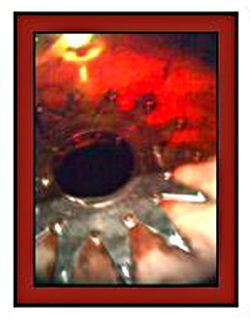
And last but not least, the
Church of the Agony in the Garden of Gethsemane where
Judas betrayed Christ with a kiss. The olive trees in that
garden, so thick and gnarled in almost grotesque fashion,
seem to suggest their own pain, here where Christ agonized
over his fate. And as some olive trees have been documented
to live for over 2,000 years, is it possible that one of these
was present on that fateful night?

“My Father
if it is possible, let this cup pass from me;
-
Matthew 26:39
It is hard to describe the
emotions one can feel when touchstones have been transported
from a revered text, to the ground beneath your feet. In an
attempt at a secular translation, be we so trite as to resort
to the clichéd cinematic line: Toto, I have a feeling
we’re not in Kansas anymore.”
We did not however opt to make the trip to
the Dead Sea for an hour and a half swim with the rest of
the group on the next to last day of the pilgrimage. Rather
we spent an afternoon at the fabulous Israel Museum,
which only opened last January. It is here, ironically, where
the Dead Sea Scrolls are housed. (Miss the swim…catch
the Scrolls).
While there were many moments of spiritual
solemnity and breathtaking awe, the evenings were given over
to some indulgences of the flesh: cocktail parties…an
impromptu Halloween party in the Pope’s suite at the
Notre Dame of Jerusalem Center, (the hotel at which
we stayed which is owned by the Vatican) wherein one woman
came dressed as…
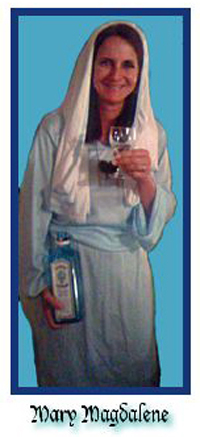
There were drinks at the King
David (the most famous hotel in Israel)… a great dinner
at a restaurant in the hip German Colony neighborhood in West
Jerusalem … brandy and fine cigars to cap an evening
before departure… for one does not live by bread
alone, (Matthew 4.4).
We all have narratives that govern or shape
our lives. Some include chapters on faith, others do not.
Whatever the stories, we believe in the need whenever possible,
to try to bring them to life. And in this case, if we may
coin a phrase once uttered in a far different context, “Mission
Accomplished!”
***
"Show Me A Sign!"
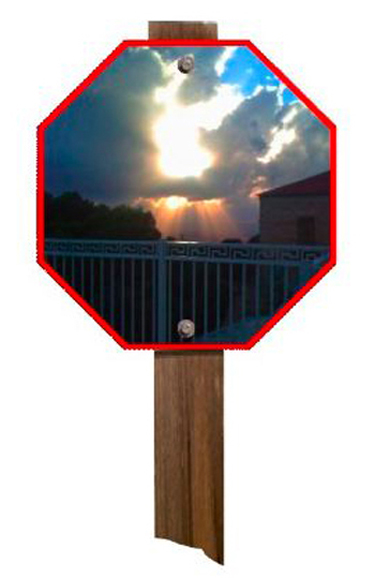
Mt.
Tabor, Israel; Ron Vazzano 2010 ©
***
"Heads, Count" in Jerusalem:
Part II
We have seen people who are said to “wear
their hearts on their sleeves.” A wonderful metaphor
for describing those who tend to be transparent in their emotions.
In Jerusalem last month, we could not help but be struck by
perhaps a variation on that metaphor: wearing one’s
faith on one’s head. Not so poetic, but seemingly
so apt. At every turn there is assertive headgear that proclaims
one’s religious and—by extension— cultural
beliefs.
In a city that is 2/3’s Jewish, one shouldn’t
be surprised to see many citizens wearing yarmulkes.
And then of course there are the many rabbis in their classic
round black hats, which don’t seem to have a formal
name as far as we can tell. And they are not to be confused
we learn, with the shtofener or shtreimal.
Though also round, these are hats of fur and are donned more
for religious rites, than casual street wear.
At the Western Wall, some add the tefillin
which is a small black box worn attached to the head with
a strap that contains inscriptions of prayers. Go to the other
side of the wall and you suddenly find Muslims wearing kufis
on heads bowed deeply in prayer. As an aside, only those of
that faith are allowed inside a Mosque. With all the controversy
regarding the building of a Mosque at Ground Zero in our country,
it would be interesting to see what actually goes on in these
places of worship.
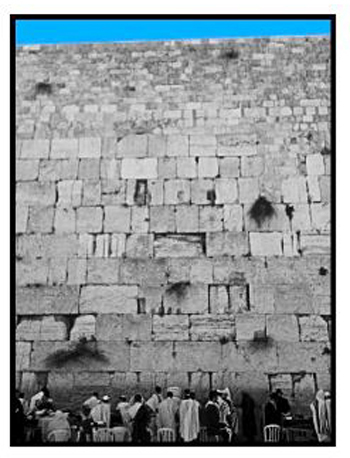
Western
Wall, Jerusalem, Ron Vazzano, 2010©
Suddenly a Greek Orthodox priest might appear on the street,
in a hat tall enough, cylindrical enough and black enough,
called a kamelaukion, as if to trump all previous
headgear.
On the women’s side there are in all
sorts of variations on a theme. They range from the full-on
burqa—which we found an uncomfortable sight
to behold— to the more relaxed scarves about the head
called al-amiras and shaylas, or simply
hijabs. And then of course here we are, the visiting
Catholics: bare of head though bold of moves. Watch how we
cut through all the headwear on Via Delorosa, in a very public
display of the Stations of the Cross. Only two percent
of the population are Christians (according to our guide)
but the Christian Quarter, what with the pilgrimage trade,
is the most visited part of the Old City.
Given the tumultuous history of the region, we found the effect
of all of this a bit unsettling. This is a pot which hasn’t
melted, if we might mix metaphors. We saw no coming together
of head coverings in the ten days we visited; heard no singing
of Kumbaya. Rather the messages woven into the various
fabrics seemed to be: I can out-pray you. My way is better
than yours. We found the contrast between our essentially
secular country—all fervent atheist contentions aside—and
this faith-on-the-head world really striking.
And as if to punctuate this last point, we
ran across an article in the New York Post as we
were concluding this piece, highlighted by this excerpt:
Muslim
woman says roller-skating rink discriminated against her
|
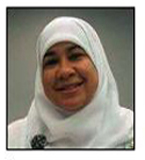 |
The
venue’s rules, posted at the entrance read: “No
Hats. No Headwear. No Exceptions.”
Colon said her religious hijab shouldn’t count
under that policy—and tried to appeal to a rink
manager.
“We wear this for religious reasons, Colon said.
“But they didn’t want to hear that.”
|
***
Winter Morning on the West Coast
The lascivious clouds
smoky, plush
with Botticelli thighs
roll atop the mountain range
for a morning’s tryst;
each smothering her prone
compliant mate.
The earth enraptured
and now the rain
the sweat of their passion—
the day postponed.
Then back to sleep.
There’ll be no sign of light between
them
at least until noon.
If that.
—Ron Vazzano
***
fini
|
